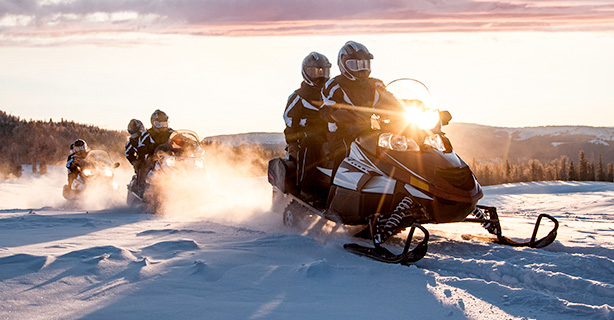5 snowmobiling safety tips
0 min. read
As the temperatures drop and the snow starts piling up, you're getting ready to once again hit the trails on your snowmobile. Whether you're a veteran rider or you're just discovering this wonderful winter pastime this year, remember—that's a big, heavy machine you're operating, often in challenging weather conditions. So before you head out for your next snowmobile ride, check out these five safety tips.
1. Check the weather forecast—and dress accordingly
One of the easiest and most important things you can do before hopping on your snowmobile is to keep an eye on the weather. Even if it looks nice outside when you're about to leave, that doesn't necessarily mean it'll stay that way—especially if you ride in the mountains, where weather can change quickly and forecasting is more difficult.
Once you've checked the forecast, make sure you have the proper gear for the elements. Even if the weather looks favorable, remember, it's always better to be too warm and stop to shed a layer than be unprepared and at risk for frostbite. Even in ideal conditions, be sure you've got:
Waterproof boots
Coat
Snow pants
Warm hat
Helmet
Gloves
Depending on the weather, you may also need to delay your ride. You don't want to be caught in a situation where blowing snow and wind reduce visibility—that's how you can end up lost or in an accident.
2. Avoid excessive speeds
It can be fun to get out on the trail and watch the wintry countryside rush by, but make sure you aren't going too fast. Excessive speed puts you—and anyone else you ride with—at a higher risk for accidents and injury. By traveling at a moderate pace, you're better able to react to, and avoid, unexpected obstacles and other riders on the trail.
If you encounter other riders, it's especially important to slow down and be cautious as you go by. Snowmobile trails are often narrow and bordered by ditches or trees, which makes safe, controlled riding crucial to keeping yourself and other snowmobilers in safe positions.
3. Keep up with your snowmobile maintenance
Before you hit the trails, make sure your snowmobile is ride-ready after several months in the garage. Have a local mechanic tune your ride up, or—if you plan to do your own maintenance—crack open the owner's manual and follow the recommended service schedule the manufacturer outlined. Be sure to check:
Brakes
Battery
Oil levels
Drive belt
Skis
Handlebars
Headlights and taillights
4. Stay off the ice
If you ride in an area where rivers or lakes freeze over in the winter, avoid traveling across them on your snowmobile. There's always a chance the ice may not be strong enough to support your snowmobile, putting you at risk of falling through. And even if you're confident the ice is thick enough—if your local lake is dotted with ice fishing shacks and even some trucks, for example—keep in mind that traction on ice is almost nonexistent. By driving your snowmobile on ice, you risk losing control or hitting another snowmobile.
5. Take a snowmobile safety course
Even if you've spent decades riding snowmobiles, a safety course is an excellent refresher. These courses cover foundational safety information and rules of the road (or trail), including:
Operating your snowmobile
Standard snowmobile controls
Using hand signals to communicate your moves to other riders
Together, let's help ensure every snowmobiler out on the trails returns home after a safe and enjoyable ride. That starts with practicing good riding habits, following local and state laws, and setting a good example for your fellow riders. If you'd like to learn more, give us a call—we're here to help.
Related links
Ready to insure your snowmobile ahead of riding season? Check out the insurance options available to you through Dairyland® off-road insurance.
Check out our insurance discounts to see where you can save on your off-road coverage—you could qualify for more money-saving discounts than you realize.
The general information in this blog is for informational or entertainment purposes only. View our blog disclaimer.
*Data accuracy is subject to this article's publication date.







